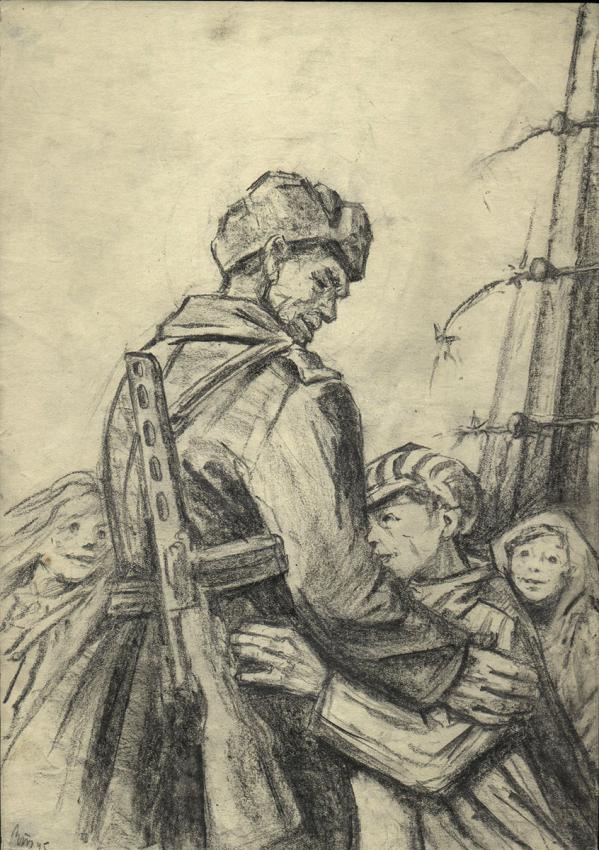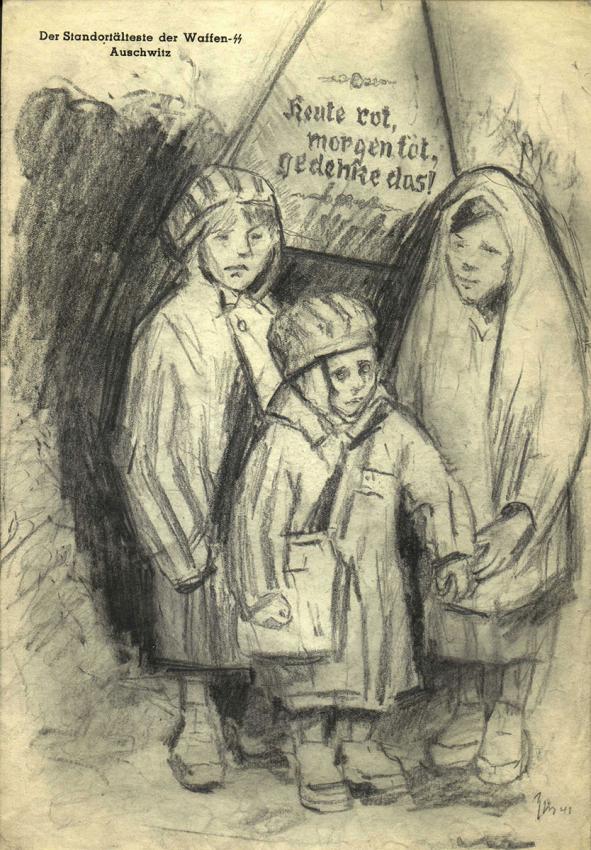“For the children of Ilya and Natasha—for all the children in the world—so that they will never be forgotten.”
This is the dedication written by artist Zinovii Tolkatchev in his album Pirhei Auschwitz (Flowers of Auschwitz), published in the spring of 1945. The album depicts the children of Auschwitz, “the flowers of life,” as the artist called them as he encountered them on entering the camp with the Red Army unit that liberated the prisoners in January 1945. He captured the children’s images on blank forms found in the camp headquarters. His empathy for the young inmates was so profound that, pointing to a sketch of two orphans, he felt compelled to exclaim: “Do you see that girl? She’s my daughter!” Zinovii Tolkatchev, who had fought in the ranks of the Red Army, regarded the children—the sons and daughters of his fellow Jews—as his own.
The album was published in Poland shortly after the actual events took place. Some six months later, Tolkatchev was discharged from the army and he returned to his family. His work remains an extraordinarily powerful testimony. Neither the Majdanek and Auschwitz Series, nor the Flowers of Auschwitz are works which praise the victors or testify to the joy of the liberated. Rather, they constitute an indictment of the horror of the camps, which, even after they were liberated, remained sites of death and destruction.
In 1941, at the age of 39, already married, and the father of two, Tolkatchev returned to the ranks of the Red Army, serving as his unit’s official artist until 1945. His task was to document the ongoing hostilities with his pen and sketchbook, for which he received a medal in 1968. The drawings themselves, however, remained in Poland.
One cold, snowy Ukrainian winter, 53 years after the war, in a Kiev apartment overflowing with books and paintings, this writer met Ilya and Annel (Natasha) – the artist’s children, to whom he had dedicated the album. At the meeting they agreed to transfer the drawings to Yad Vashem for safekeeping. “Father would have wanted to see them there,” they explained.
The works arrived at Yad Vashem in April 2000. And there the story might well have ended, but for the appearance, a month later, of Anna Pikovsky at Yad Vashem. Clutching a colorful bag containing an object, which she wanted to donate to the museum, she met with Haviva Peled-Carmeli, Director of Yad Vashem’s Artifacts Retrieval Department. Pikovsky removed a small, black leather shoe from the bag and proceeded to tell its story.
She and her daughter had been students of Ukrainian Jewish artist Nahum Ostchinsky, who had mounted an exhibition of works by Ukrainian children on the subject of WWII at the studio where he taught. Zinovii Tolkatchev himself visited the exhibition in Ostchinsky’s studio and was so impressed by what he saw that he made the instant decision that this would be a suitable safe-haven for a child’s shoe that he had removed from the mountain of shoes in Auschwitz all those years ago. When Pikovsky decided to move to Israel, she went to bid farewell to her beloved teacher, Nahum Ostchinsky, who, on hearing her plans, told her that he had a farewell gift for her. He presented her with the child’s shoe from Auschwitz, so that it would finally be kept in the appropriate place—Yad Vashem.
Meanwhile, on Peled-Carmeli’s recent visit to the studio in Kiev, Ostchinsky presented her with a book in which he inscribed the goal of his exhibition: “My students and I spent years working on this book about the war and the human suffering, for the sake of peace on earth and on behalf of the goodness of people who fight against evil.” Thus, within the space of a single month, Yad Vashem’s Museums Division received Tolkatchev’s sketches and the shoe. The shoe arrived at its new home where it found its twin in the sketch drawn in the very place it had come from—that “other planet” called Auschwitz. With this, a circle has been closed.
First published in Yad Vashem Jerusalem magazine, #19, July 2000










